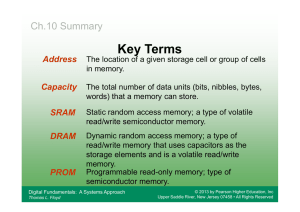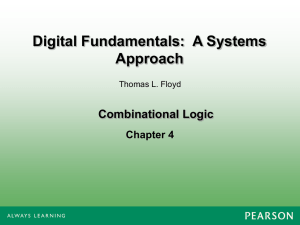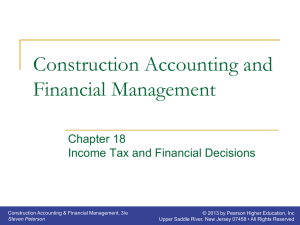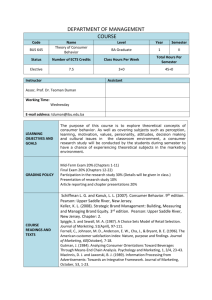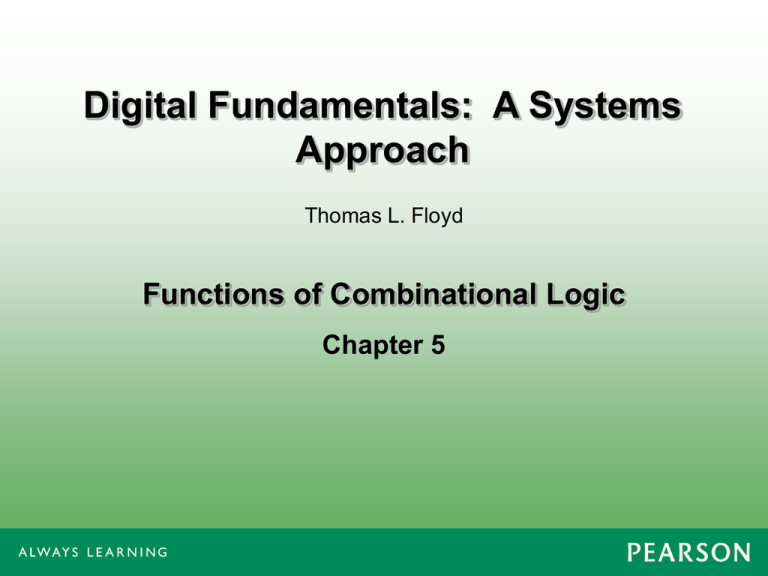
Digital Fundamentals: A Systems
Approach
Thomas L. Floyd
Functions of Combinational Logic
Chapter 5
Ch.5 Summary
Bottling Control System
Digital Fundamentals: A Systems Approach
Thomas L. Floyd
© 2013 by Pearson Higher Education, Inc
Upper Saddle River, New Jersey 07458 • All Rights Reserved
Ch.5 Summary
Bottling Control System
Information is entered into the system using a keypad,
encoder, and register.
Digital Fundamentals: A Systems Approach
Thomas L. Floyd
© 2013 by Pearson Higher Education, Inc
Upper Saddle River, New Jersey 07458 • All Rights Reserved
Ch.5 Summary
Bottling Control System
The display circuit
contains decoder and
code converter circuits.
Digital Fundamentals: A Systems Approach
Thomas L. Floyd
© 2013 by Pearson Higher Education, Inc
Upper Saddle River, New Jersey 07458 • All Rights Reserved
Ch.5 Summary
Bottling Control System
The comparator,
counter, adder,
and register
circuits
Digital Fundamentals: A Systems Approach
Thomas L. Floyd
© 2013 by Pearson Higher Education, Inc
Upper Saddle River, New Jersey 07458 • All Rights Reserved
Ch.5 Summary
Bottling Control System
The decoder,
multiplexer (MUX),
and demultiplexer
(DEMUX) circuits.
Digital Fundamentals: A Systems Approach
Thomas L. Floyd
© 2013 by Pearson Higher Education, Inc
Upper Saddle River, New Jersey 07458 • All Rights Reserved
Ch.5 Summary
Half-Adders
Basic rules of binary addition are
performed by a half adder, which
accepts two binary inputs (A and B)
and provides two binary outputs
(Carry-out and Sum).
The logic symbol and equivalent circuit are:
Digital Fundamentals: A Systems Approach
Thomas L. Floyd
© 2013 by Pearson Higher Education, Inc
Upper Saddle River, New Jersey 07458 • All Rights Reserved
Ch.5 Summary
Full-Adders
A full adder accepts three binary inputs (A, B,
and Carry-in) and provides two binary outputs
(Carry-out and Sum). The truth table
summarizes the operation.
A full-adder can be constructed from two half
adders as shown:
Digital Fundamentals: A Systems Approach
Thomas L. Floyd
© 2013 by Pearson Higher Education, Inc
Upper Saddle River, New Jersey 07458 • All Rights Reserved
Ch.5 Summary
Full-Adders
1
A
0
B
S
S 1
A
Cout 0
B
S
S
0
Cout
1
1
For the given inputs, determine the
intermediate and final outputs of the
full adder.
Sum
Cout
1
The first half-adder has inputs of 1 and 0; therefore the
Sum =1 and the Carry out = 0.
The second half-adder has inputs of 1 and 1; therefore the
Sum = 0 and the Carry out = 1.
The OR gate has inputs of 1 and 0, therefore the final
carry out = 1.
Digital Fundamentals: A Systems Approach
Thomas L. Floyd
© 2013 by Pearson Higher Education, Inc
Upper Saddle River, New Jersey 07458 • All Rights Reserved
Ch.5 Summary
Parallel Adders
Full adders are combined into parallel adders that can add binary
numbers with multiple bits. A 4-bit adder is shown.
The output carry (C4) is not ready until it propagates through all of the
full adders. This is called ripple carry, which delays the addition
process.
Digital Fundamentals: A Systems Approach
Thomas L. Floyd
© 2013 by Pearson Higher Education, Inc
Upper Saddle River, New Jersey 07458 • All Rights Reserved
Ch.5 Summary
Adder Expansion
Two four-bit adders can be cascaded to form an
8-bit adder as shown.
The carry-in (C0) pin on the lower-order adder is grounded and the
carry-out pin is connected to the C0 pin of the higher-order adder.
Digital Fundamentals: A Systems Approach
Thomas L. Floyd
© 2013 by Pearson Higher Education, Inc
Upper Saddle River, New Jersey 07458 • All Rights Reserved
Ch.5 Summary
An Adder Application
A voting system
Digital Fundamentals: A Systems Approach
Thomas L. Floyd
© 2013 by Pearson Higher Education, Inc
Upper Saddle River, New Jersey 07458 • All Rights Reserved
Ch.5 Summary
Ripple Carry Adder
The parallel adder introduced earlier is a ripple carry adder.
Because the carry from each adder is applied to the next, time
must provided for the carry bits to “ripple” through the circuit.
If each adder
has an 8 ns
delay, it takes
32 ns for the
carry to work
its way through
the adder (as
shown).
Digital Fundamentals: A Systems Approach
Thomas L. Floyd
© 2013 by Pearson Higher Education, Inc
Upper Saddle River, New Jersey 07458 • All Rights Reserved
Ch.5 Summary
Look-Ahead Carry Adder
A look-ahead carry adder anticipates the carry that will be
generated by each adder stage, and produces the required
carry at one time, making the adder faster than a ripple carry
adder.
Carry generation: When
a carry signal is produced
internally (i.e., a carry-in is
not involved).
Carry propagation: When
an input carry signal is
involved in producing a
carry out signal.
Digital Fundamentals: A Systems Approach
Thomas L. Floyd
© 2013 by Pearson Higher Education, Inc
Upper Saddle River, New Jersey 07458 • All Rights Reserved
Ch.5 Summary
A Four-Stage Look-Ahead Carry Adder
Digital Fundamentals: A Systems Approach
Thomas L. Floyd
© 2013 by Pearson Higher Education, Inc
Upper Saddle River, New Jersey 07458 • All Rights Reserved
Ch.5 Summary
Comparators
The function of a comparator is to compare the magnitudes of
two binary numbers to determine the relationship between
them. In the simplest form, a comparator can test for equality
using XNOR gates.
How could you test
two 2-bit numbers
for equality?
AND the outputs of two XNOR gates
Digital Fundamentals: A Systems Approach
Thomas L. Floyd
© 2013 by Pearson Higher Education, Inc
Upper Saddle River, New Jersey 07458 • All Rights Reserved
Ch.5 Summary
Comparators
IC comparators provide outputs to indicate which of the
numbers is larger or if they are equal. The bits are numbered
starting at 0, rather than 1 as in the case of adders.
Cascading
inputs are
provided to
expand the
comparator to
larger numbers.
Digital Fundamentals: A Systems Approach
Thomas L. Floyd
© 2013 by Pearson Higher Education, Inc
Upper Saddle River, New Jersey 07458 • All Rights Reserved
Ch.5 Summary
Decoders
A decoder is a logic circuit that detects the presence of a
specific combination of bits at its input. A simple decoder that
detects the presence of the binary code 1001 is shown.
The circuit on the left has an active HIGH output for
the inputs shown; the circuit on the right shows the
logic expressions for the various gate outputs.
Digital Fundamentals: A Systems Approach
Thomas L. Floyd
© 2013 by Pearson Higher Education, Inc
Upper Saddle River, New Jersey 07458 • All Rights Reserved
Ch.5 Summary
Decoders
IC decoders have multiple outputs to decode any combination of inputs.
For example the binary-to-decimal decoder shown here has 16 outputs –
one for each combination of binary inputs. The first 8 lines of the circuit
truth table are shown.
Digital Fundamentals: A Systems Approach
Thomas L. Floyd
© 2013 by Pearson Higher Education, Inc
Upper Saddle River, New Jersey 07458 • All Rights Reserved
Ch.5 Summary
A Decoder Application
A simplified I/O
Port System
Digital Fundamentals: A Systems Approach
Thomas L. Floyd
© 2013 by Pearson Higher Education, Inc
Upper Saddle River, New Jersey 07458 • All Rights Reserved
Ch.5 Summary
BCD Decoder/Driver
Another useful decoder is the 74LS47. This is a BCDto-seven segment display with active LOW outputs.
The a-g outputs are
designed for much higher
current than most devices
(hence the word driver in
the component’s name).
Digital Fundamentals: A Systems Approach
Thomas L. Floyd
© 2013 by Pearson Higher Education, Inc
Upper Saddle River, New Jersey 07458 • All Rights Reserved
Ch.5 Summary
Leading Zero Suppression
The 74LS47 features leading zero suppression, which blanks
unnecessary leading zeros but keeps significant zeros as
illustrated here. The BI/RBO output is connected to the RBI
input of the next decoder.
Digital Fundamentals: A Systems Approach
Thomas L. Floyd
© 2013 by Pearson Higher Education, Inc
Upper Saddle River, New Jersey 07458 • All Rights Reserved
Ch.5 Summary
Trailing Zero Suppression
Trailing zero suppression blanks unnecessary trailing zeros
to the right of the decimal point as illustrated here. The RBI
input is connected to the BI/RBO output of the following
decoder.
Digital Fundamentals: A Systems Approach
Thomas L. Floyd
© 2013 by Pearson Higher Education, Inc
Upper Saddle River, New Jersey 07458 • All Rights Reserved
Ch.5 Summary
Encoders
An encoder accepts an active logic level on one of its
inputs and converts it to a coded output, such as BCD
or binary.
The decimal to BCD is an encoder
with an input for each of the ten
decimal digits and four outputs
that represent the BCD code for
the active digit. The basic logic
diagram is shown. There is no
zero input because the outputs are
all LOW when the input is zero.
Digital Fundamentals: A Systems Approach
Thomas L. Floyd
© 2013 by Pearson Higher Education, Inc
Upper Saddle River, New Jersey 07458 • All Rights Reserved
Ch.5 Summary
Encoders
The 74HC147 is an example of an IC encoder. It is
has ten active-LOW inputs and converts the active
input to an active-LOW BCD output.
This device is a priority
encoder. This means that if
more than one input is active,
the component responds to
the highest numbered input.
Digital Fundamentals: A Systems Approach
Thomas L. Floyd
© 2013 by Pearson Higher Education, Inc
Upper Saddle River, New Jersey 07458 • All Rights Reserved
Ch.5 Summary
An Encoder Application
A keypad
encoder
Digital Fundamentals: A Systems Approach
Thomas L. Floyd
© 2013 by Pearson Higher Education, Inc
Upper Saddle River, New Jersey 07458 • All Rights Reserved
Ch.5 Summary
Code Converters
There are various code converters that change one
code to another. Two examples are the four bit binaryto-Gray converter and the Gray-to-binary converter.
Show the
conversion of
binary 0111 to
Gray and back
to binary.
Digital Fundamentals: A Systems Approach
Thomas L. Floyd
© 2013 by Pearson Higher Education, Inc
Upper Saddle River, New Jersey 07458 • All Rights Reserved
Ch.5 Summary
Multiplexers
A multiplexer (MUX) selects one of several data (D)
inputs and routes data from that input to the output.
The data line that is selected is determined by the
select (S) inputs.
The multiplexer shown has
two select (S) inputs that are
used to select one of four
data (D) inputs.
Which data line is
selected if S1S0 = 10?
The select input (10) connects data line 2 to the output.
Digital Fundamentals: A Systems Approach
Thomas L. Floyd
© 2013 by Pearson Higher Education, Inc
Upper Saddle River, New Jersey 07458 • All Rights Reserved
Ch.5 Summary
Multiplexers
Here is the logic diagram for a 4-input multiplexer.
Digital Fundamentals: A Systems Approach
Thomas L. Floyd
© 2013 by Pearson Higher Education, Inc
Upper Saddle River, New Jersey 07458 • All Rights Reserved
Ch.5 Summary
A 16-Bit Multiplexer
Digital Fundamentals: A Systems Approach
Thomas L. Floyd
© 2013 by Pearson Higher Education, Inc
Upper Saddle River, New Jersey 07458 • All Rights Reserved
Ch.5 Summary
A 7-Segment Display Multiplexer
Digital Fundamentals: A Systems Approach
Thomas L. Floyd
© 2013 by Pearson Higher Education, Inc
Upper Saddle River, New Jersey 07458 • All Rights Reserved
Ch.5 Summary
Demultiplexers
A demultiplexer (DEMUX) performs
the opposite function from a MUX. It
switches data from one input line to
two or more data lines depending on
the select inputs.
Data is applied to one of the data input
pin, and routed to the selected output
line depending on the select variables.
Note that the outputs are active-LOW.
Digital Fundamentals: A Systems Approach
Thomas L. Floyd
© 2013 by Pearson Higher Education, Inc
Upper Saddle River, New Jersey 07458 • All Rights Reserved
Ch.5 Summary
Parity Generators/Checkers
Parity is an error detection method
that uses an extra bit appended to a
group of bits to force them to be either
odd or even. In even parity, the total
number of ones is even; in odd parity
the total number of ones is odd.
The ASCII letter S is 1010011. Show
the parity bit for the letter S with odd
and even parity.
S with odd parity =
11010011
S with even parity = 01010011
Digital Fundamentals: A Systems Approach
Thomas L. Floyd
© 2013 by Pearson Higher Education, Inc
Upper Saddle River, New Jersey 07458 • All Rights Reserved
Ch.5 Summary
Parity Generators/Checkers
A 9-bit parity checker/generator can be used to generate
a parity bit or to check an incoming data stream for even
or odd parity.
Checker: The even output will normally
be HIGH if the data lines have even parity;
otherwise it will be LOW. Likewise, the
odd output will normally be HIGH if the
data lines have odd parity; otherwise it will
be LOW.
Generator: To generate even parity, the
parity bit is taken from the odd parity
output. To generate odd parity, the output
is taken from the even parity output.
Digital Fundamentals: A Systems Approach
Thomas L. Floyd
© 2013 by Pearson Higher Education, Inc
Upper Saddle River, New Jersey 07458 • All Rights Reserved
Ch.5 Summary
A Simplified Data Transmission System with
Error Detection
Digital Fundamentals: A Systems Approach
Thomas L. Floyd
© 2013 by Pearson Higher Education, Inc
Upper Saddle River, New Jersey 07458 • All Rights Reserved
Ch.5 Summary
VHDL and Verilog Full Adder
Digital Fundamentals: A Systems Approach
Thomas L. Floyd
© 2013 by Pearson Higher Education, Inc
Upper Saddle River, New Jersey 07458 • All Rights Reserved
Ch.5 Summary
Key Terms
Full-adder
A digital circuit that adds two bits and an input
carry bit to produce a sum and an output carry.
Cascading
Connecting two or more similar devices in a
manner that expands the capability of one
device.
A method of binary addition in which the
output carry from each adder becomes the
input carry of the next higher order adder.
Ripple
carry
Look-ahead
carry
A method of binary addition whereby carries from
the preceding adder stages are anticipated, thus
eliminating carry propagation delays.
Digital Fundamentals: A Systems Approach
Thomas L. Floyd
© 2013 by Pearson Higher Education, Inc
Upper Saddle River, New Jersey 07458 • All Rights Reserved
Ch.5 Summary
Key Terms
Decoder
A digital circuit that converts coded information
into a familiar or noncoded form.
Encoder
A digital circuit that converts information into a
coded form.
Priority
encoder
An encoder in which only the highest value input
digit is encoded and any other active input is
ignored.
Multiplexer A circuit that switches digital data from several input lines
(MUX) onto a single output line in a specified time sequence.
Demultiplexer A circuit that switches digital data from one input line onto a
(DEMUX) several output lines in a specified time sequence.
Digital Fundamentals: A Systems Approach
Thomas L. Floyd
© 2013 by Pearson Higher Education, Inc
Upper Saddle River, New Jersey 07458 • All Rights Reserved

